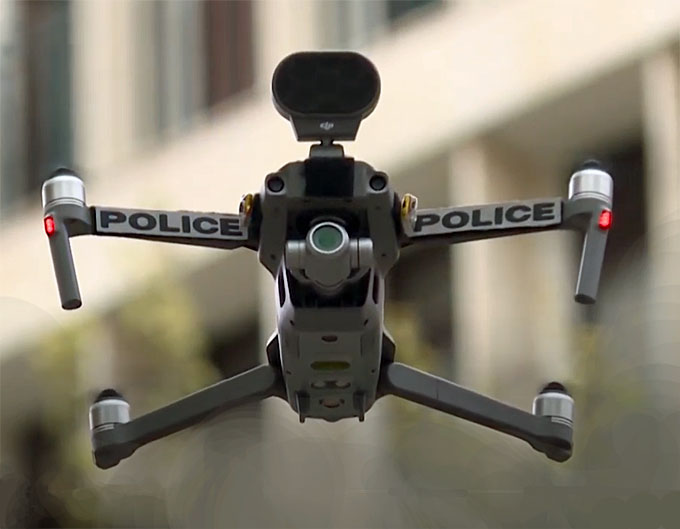
May 3, 2020 – In Breaking News – USA TODAY
“This is the Daytona Beach Police Department. We apologize for the inconvenience, but due to COVID-19, this park is currently closed.”
So says a drone with a loud speaker attached to its top.
The coronavirus pandemic has forced police departments in the country and around the globe to fundamentally change the way they enforce laws.
Police agencies are increasingly relying on these flying contraptions to do what they have not had to do before: policing while socially distancing.
(The Daytona Beach Police Department is now equipped with two more drones to add to its six, but the loaner drones police are using to enforce closures and other social distancing measures during the coronavirus pandemic are equipped with intercoms. Courtesy of WKMG News 6 ClickOrlando and YouTube. Posted on April 7, 2020.)
Over the past month, several law enforcement agencies have unveiled drones that broadcast announcements at parks, beaches and homeless camps to enforce stay-at-home orders and social-distancing guidelines.

In Daytona Beach, Florida, officials say the drones can also be used during rescue operations, such as giving a drowning person a life preserver without physical contact.
“We started thinking about ways of how we can limit the ability to transmit (COVID-19),” said Messod Bendayan, spokesman for the Daytona Police Department.
“Instead of risking an officer, we just fly the drone and have the drone speak a message. It keeps officers safe and keeps people safe.”
(Police in Madrid used drones to broadcast audio messages asking the public to stay at home, as restrictions on movement were enforced. Courtesy of ABC News and YouTube. Posted on Mar 16, 2020.)
But civil rights groups have pushed back against the use of such technology, saying some of its capabilities are invasive and pose constitutional dangers.
These include the ability to detect someone’s body temperature from a distance.
To civil rights and privacy advocates, this amounts to an indiscriminate warrantless search – obtaining the private health information of people who did not give consent and aren’t under a criminal investigation.
(The Honolulu Fire Department today will start using three drone-operation teams to help enforce Mayor Kirk Caldwell’s stay-at-home and work-at-home order at beaches around Oahu, city officials announced. Courtesy of Star-Advertiser and YouTube. Posted on Apr 11, 2020.)
“People have a right to privacy. You can’t just take their temperature without any reason.”

“I think this is just an example of something that police departments have a tendency to do.“
“Someone sells them on a new technology and they can come up with what they think is reason to use it and they use it, but they don’t necessarily think about how invasive it might be,” said Caleb Kruckenberg, litigation counsel for the New Civil Liberties Alliance.
(Amid the coronavirus crisis in France, authorities are turning to drones to warn the population and enforce confinement measures in Marseille, Tuesday, March 24. Courtesy of VOA News and YouTube. Posted on Mar 24, 2020.)
The Washington, D.C.-based group recently sent a letter asking the Daytona Beach Police Department to stop using drones that detect body temperatures.
Bendayan said the main function of the department’s drones is to police public places such as parks.
He said officials were considering using drones to find out who may have fever, but they have not done so, and any plans to use the technology to measure people’s temperatures are limited only to those entering the police department lobby.
(A town in Wales is using a drone with a pre-recorded message to urge people to stay at home. The Neath Port Talbot Council has teamed up with South Wales Police to deploy the drone in hotspots where people have not been following orders. Courtesy of The Telegraph and YouTube. Posted on Mar 28, 2020.)
Continue reading… Police agencies are using drones to enforce stay-at-home orders, raising concerns among civil rights groups
AST strives to meet a 3 STAR trustworthiness rating, based on the following criteria:
- Provides named sources
- Reported by more than one notable outlet
- Includes supporting video, direct statements, or photos

















